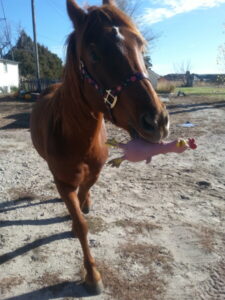Stimulus Control?
With clicker training the first thing we usually have to do is convince our horses that we want them to think for themselves. We take horses who have been trained traditionally to stand quietly and wait for us to tell them what to do and we tell them we will give them food if they can think of a way to earn it. Once that ‘clicks’ with them it blows their minds. All of a sudden we have a horse who wants to do things. They often go from well behaved to over enthusiastic.
This is what we wanted from them. Now that we have all that enthusiasm and try, what are we supposed to do with it?
Our once well behaved horse is now pawing and exploring with his mouth. Touching everything he can get his nose on. Following us around and doing all the tricks he knows, trying to earn another treat. We’ve created a monster!
Now what?
Horses don’t automatically know when and how we want them to think for themselves and when we want them to do what we say. We offer them choice, then only want them to choose when it is handy for us. We’ve asked them to have ideas and opinions and that is all they are doing.
It is up to us to explain clearly what we want from them, what actions will earn them a reward. To put actions on cue and explain that we will only give treats for the action when we have given the cue.
As always the fault and responsibility falls on us. Luckily for us we know that responsibility equals power.
First, is it really hurting anything to have your horse exploring and wanting to play? They can make a nuisance of themselves, true. If they are loose wandering around with us they can start mugging or throwing behaviors at us in an attempt to find one that will be rewarded. The easiest way to take care of the problem is to put them back out to pasture or their stall when we are done working.
To actually solve the problem we need to teach them that behaviors are only rewarded when we ask for them. Teaching a strong default behavior of standing still looking straight ahead gives them a behavior that is very desirable to us that they can offer when they want attention and a reward. They can choose and explore all they want, we will only reward for the things we want. If we stand quietly and ignore behavior when we aren’t asking for it, then reward them as soon as they stand still they will quickly learn that random behaviors don’t earn treats.
We need to be consistent with our clicks, only rewarding what we have asked for or are looking for. As hard as it can be we need to stay all done after we have given an all done cue. Even when they offer something really good after we give it. Time after we have given the all done cue can be spent scratching and grooming. Those can be another way to reward instead of treats after we have finished official work. A good grooming when we are finished working can also be an extended all done cue. Horses are creatures of habit, we can use habits to let them know when we are working and when we are finished.
We get what we have rewarded. If we aren’t consistent we get behaviors that aren’t consistent.
In the end though, perhaps the best way to deal with your pet monster is to remember that they are thinking, feeling animals who want to play and want to please. Instead of thinking of them as nuisances, we can take joy in their interest and curiosity. We can let them explore and offer behaviors. We can watch what they do and learn about them from the behaviors they offer when we aren’t asking. Some of my horses best tricks and talents were their ideas. The difference between brilliance and nuisance is all in how we look at it.

Love this post, and your attitude toward training. You always keep the emotional well-being of the horse top of mind! xx
<3